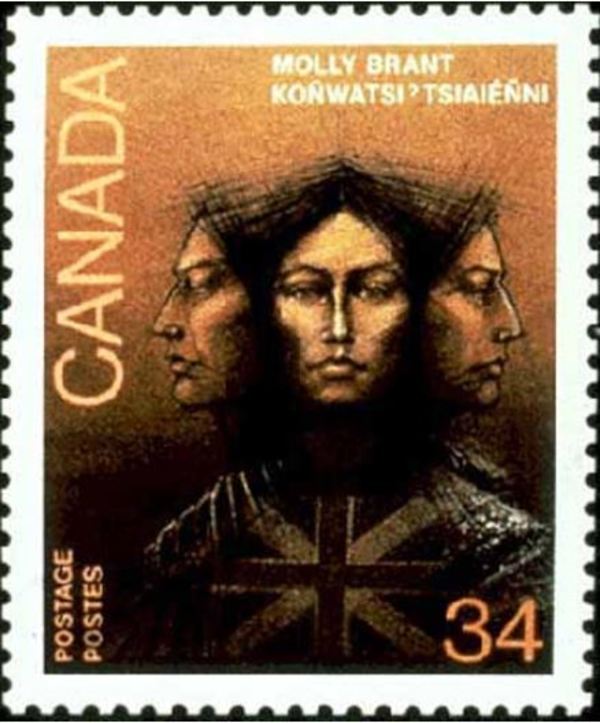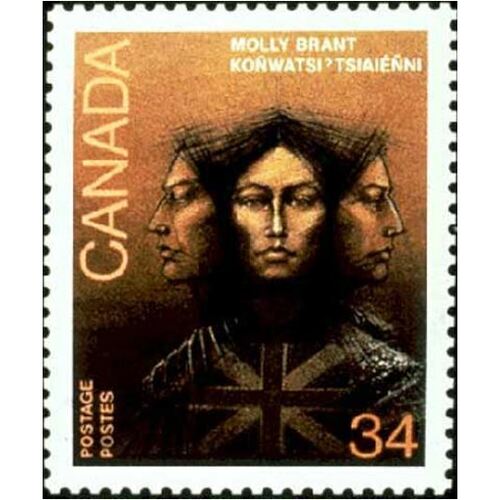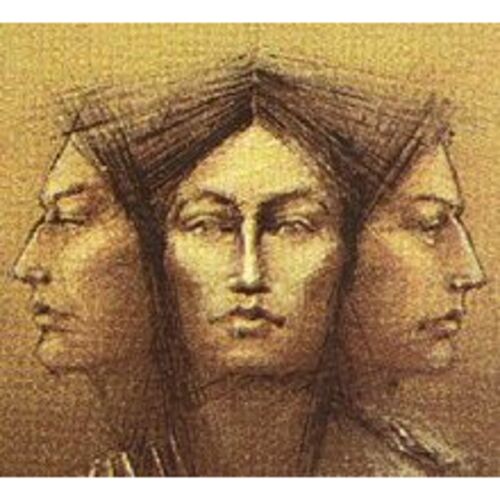
Source: Link
KOÑWATSIˀTSIAIÉÑNI (Gonwatsijayenni, meaning someone lends her a flower, Mary Brant), Mohawk, head of the Six Nations matrons; b. c. 1736; d. 16 April 1796 at Kingston (Ont.).
Details of Mary Brant’s birth, parentage, and early years are obscure. She may have been born at the upper Mohawk castle of Canajoharie (near Little Falls, N.Y.), her family’s home; or, like her younger brother Joseph [Thayendanegea*], she may have been born while her parents were living in the Ohio region. John Norton* in his Journal states that Joseph was born at Cayahoga (near Akron, Ohio) and was “descended from Wyandot prisoners adopted by the Mohawks on both the father and the mother’s side.” William Allen, who had interviewed Joseph Brant’s son Joseph, stated, perhaps on the son’s authority, that Brant’s father was an Onondaga chief. This assertion would not negate Norton’s claim that the Brants were of Wyandot ancestry and Mohawk nationality since, in the matrilineal Iroquois society, children took the nationality of their mother. Some authorities claim that the father of Mary and Joseph was a respected sachem. According to Norton, he was “a great Warrior” who died when the children were young. The mother then took Mary and Joseph with her to Canajoharie shortly before the outbreak of the Seven Years’ War. Eleazar Wheelock, at whose mission school in Connecticut Joseph Brant once studied, said that the Brants were “a Family of Distinction” among the Mohawks.
There was a persistent tradition in the Mohawk valley among both whites and Indians that Mary and Joseph Brant were descended from King Hendrick [Theyanoguin*]. The 19th-century historian and archivist Lyman Copeland Draper, who did painstaking research on the Brant genealogy, found confirmation of such a relationship. A Mohawk woman named Katy Moses, aged 77 in 1879 and “distantly related to Brant’s last wife,” stated that “she learned many years ago from aged Mohawks, that Brant’s mother was a daughter of Old King Hendrick.” Joseph Brant’s granddaughter Charlotte told Draper that Joseph’s mother was a granddaughter of Hendrick.
Mary, or Molly as she was generally known, possibly attended one of the Church of England mission schools in the Mohawk valley. Her later letters, if authentically from her own hand, show that she was mistress of a fine penmanship and a proper English style. There is some evidence, however, that she was only semi-literate and that the letters were dictated to an amanuensis.
She evidently accompanied the delegation of 12 Mohawk principal men who, under the leadership of Hendrick, went to Philadelphia in the winter of 1754–55 to discuss with Pennsylvania officials the fraudulent sale of lands in the Wyoming valley to a group of Connecticut speculators [see John Hendricks Lÿdius]. Christian Daniel Claus, who had accompanied the delegation, stated that at Albany on the return trip an English captain “fell in Love wth. Ms. Mary Brant who was then pretty likely not havg. had the small pox.”
According to a Mohawk valley tradition, Molly first attracted Sir William Johnson’s attention at a militia muster, when she leaped upon the back of a horse behind an officer and hung on to him as the horse dashed about the field, much to the amusement of the spectators. Their first child, Peter Warren Johnson, was born in 1759, the same year that Johnson’s wife Catherine Weissenberg died. Molly and Sir William had seven more children who survived infancy. Although Johnson referred to her in his will as his “prudent & faithfull Housekeeper” and to the children as his natural children, there is a persistent tradition that they were married according to Indian ceremony, which was not recognized as legal for members of the white community. Johnson treated her with every respect, furnished her and the children with every comfort and luxury befitting an upper class family, and provided generously for them in his will. He also permitted the children to bear his surname. The eldest, named in honour of Johnson’s uncle, Sir Peter Warren*, probably received his early education in the Mohawk valley but in 1772 was sent to Montreal for further schooling. In 1773 Johnson sent him to Philadelphia, where he was apprenticed to a dry-goods merchant. Indicative of his genteel upbringing were his requests to his father for a watch so that he might be on time for dinner appointments and for work, some French and English books to read at leisure, a Mohawk book so that he would not forget his Indian tongue, and help in securing a violin. Of his mother, he requested some Indian curiosities to show his Philadelphia friends. His letters indicate a close and affectionate relationship between Johnson, his Mohawk consort, and their children.
Mary Brant presided over Johnson’s household with intelligence, ability, grace, and charm, and she effectively managed the estate during Johnson’s many and prolonged absences. A contemporary author described her as a “daughter to a sachem, who possessed an uncommonly agreeable person, and good understanding.” Because of her important family connections among the Iroquois, she was also of inestimable value to Sir William during his negotiations with the Indians.
After Sir William’s death in 1774, she and her children moved to Canajoharie, for the Johnson Hall estate had passed into the hands of John Johnson*, Sir William’s white son. At Canajoharie she was highly respected both as the relict of Sir William and as a woman of quality in her own right. She maintained a comfortable existence in a well-furnished house and dressed in Indian style, but in the finest cloth. In his will Sir William had left her a lot in the Kingsland Patent (in present-day Herkimer County), a black female slave, and £200, New York currency. With her legacy she opened a store among the Indians, where she traded chiefly in rum.
Upon the outbreak of hostilities between Great Britain and the colonies, the Brants became staunch loyalists. Early in the conflict Mary Brant did all in her power to feed and assist those loyalists who had taken refuge in the woods, and she also sent ammunition to supporters of the king. In August 1777 she performed one of her most noteworthy achievements when she dispatched Indian runners to inform Barrimore Matthew St Leger’s forces, then besieging Fort Stanwix (Rome, N.Y.), of the approach of a large body of American militia. This timely warning resulted in the successful ambush of the Americans by the Indians and loyalists at nearby Oriskany.
After the battle the Oriska Indians, a part of the Oneida nation who had supported the Americans in the campaign, revenged themselves upon the Mohawks, and particularly upon Mary Brant, by attacking and despoiling both Canajoharie and Fort Hunter, N.Y., the lower Mohawk castle. Mary Brant and her family, who had lost most of their possessions in the attack, took refuge at Onondaga (near Syracuse), the capital of the Six Nations Confederacy, where she submitted her grievances to the confederacy council and was promised satisfaction.
She then moved to Cayuga (south of present Cayuga, N.Y.), where she had distant relatives; and during the months of discouragement after the Stanwix campaign, when the Indians pondered their losses and wavered in their support of the king, she rendered invaluable service by encouraging and steadying them in their alliance. In one important council she even publicly rebuked the venerable Kaieñˀkwaahtoñ, leading war chief of the confederacy, for counselling peace with the Americans. Her entreaties won over the whole council. Daniel Claus correctly assessed her influence with the Iroquois: “one word from her goes farther with them than a thousand from any white Man without Exception who in general must purchase their Interest at a high rate.”
Soon afterwards Major John Butler prevailed upon Mary Brant to come to live at Niagara (near Youngstown, N.Y.), a major military base where she could be of much use to the British by advising and interceding with the Indians. As head of a society of Six Nations matrons, which was particularly influential among the young warriors, she was highly esteemed in the confederacy. She arrived at Fort Niagara in the late fall of 1777 and for the next several months was of inestimable assistance there as a diplomat and stateswoman. She was consulted by the Indians on all issues of importance and often cautioned them against making unwise proposals to the commander of the fort.
In July 1779, at the suggestion of the commander, who found his facilities at the fort strained, she reluctantly left her elderly mother behind and went with her family to Montreal, where she placed two of her daughters in a boarding school. In the autumn of 1779, when she heard of the destruction being wrought in Iroquois country by the forces of the Sullivan-Clinton expedition [see Kaieñˀkwaahtoñ], she hastened to return to Niagara to be of what assistance she could. But she never reached Niagara, for she agreed instead to remain at Carleton Island, N.Y., where there was a large Six Nations settlement and where she was able to assuage the disgruntled and resentful Indians during the discouraging winter of 1779–80. The commander, Alexander Fraser, highly praised her leadership during those months, affirming that the Indians’ “uncommon good behaviour is in a great Measure to be ascribed to Miss Molly Brants Influence over them, which is far superior to that of all their Chiefs put together.” A woman of spirit and sometimes of temper, she remained fiercely loyal to her family and to the memory of Sir William and bitter towards the American rebels, who had driven her and her people from their homeland.
In 1783, at the end of the war, she moved to Cataraqui (Kingston, Ont.), where Haldimand ordered a house to be built for her. She lived the remainder of her life at Kingston, highly respected by her neighbours. In 1783 also, Haldimand set her pension at £100 annually, the highest paid to an Indian. In addition she received compensation from the British government for her losses during the war. She made a trip back to the Mohawk valley in 1785 and visited Schenectady, where the Americans attempted to persuade her to return with her family. Several years later she was offered financial compensation by the Americans for her confiscated lands if she and her children would return and settle, which offer she “rejected with the utmost contempt.”
Little is known of her later years, though reports of travellers afford the occasional glimpse. On 13 Sept. 1794 Mrs John Graves Simcoe [Elizabeth Posthuma Gwillim*] permitted Mary Brant, who was ill, to travel with her aboard the Mississauga from Niagara to Kingston. “She speaks English well,” noted Mrs Simcoe in her Diary, “and is a civil and very sensible old woman.” In April of the following year Mary Brant successfully prescribed a favourite Indian remedy, the root of sweet flag (acorus calamus), for Governor Simcoe*, who had been extremely ill with a persistent cough. The medicine relieved his malady “in a very short time.”
Mary Brant remained a devout Anglican, regularly attending services at St George’s in Kingston, where she “sat in an honourable place among the English.” She died on 16 April 1796 and was buried in the cemetery (now St Paul’s churchyard) in a ceremony conducted by the pastor John Stuart*, who had once been missionary to the Mohawks at Fort Hunter. All her daughters, save one who remained single, married white men of distinction in Upper Canada. Her son George Johnson, known among the Indians as Big George, farmed and taught a day school not far from Brantford for many years. Peter died in 1777 in Philadelphia while serving with the 26th Foot.
A woman of high intelligence and remarkable ability who was at ease in two cultures, Mary Brant personified the dignity and influence accorded to respected mothers among the Iroquois people. In a society in which the mothers chose the sachems and influenced the warriors, Mary Brant played a unique role. Her descent from a high ranking Indian family, her liaison with Sir William Johnson, and her own talents enabled her to wield great power at a critical moment. This power she exerted at much personal cost in a cause which she believed just. Her loyalty to her own family, to her people, and to the traditional Iroquois alliance with the crown was steadfast and enduring. The military officials who had most to do with Indian affairs during the American revolution recognized how essential her leadership was in maintaining the morale and loyalty of the Iroquois. History has subsequently been less than kind to her in often overlooking her achievements. Unquestionably she was one of the most devoted United Empire Loyalists.
BL, Add. mss 21661–892 (transcripts at PAC). Clements Library, Sydney papers, secret service payments, 1782–91, Nepean papers, compensation for Joseph and Mary Brant, 31 March 1786. N.Y. Hist. Soc. (New York), Misc. mss Haldimand, Haldimand to John Johnson, 27 May 1783. New York Public Library, Manuscripts and Archives Division, American loyalist transcripts, XXI, p.331; XLIV, pp. 107, 118; Schuyler papers, Indian boxes, box 14. PAC, MG 19, F1; RG 1, L3, 186. PRO, CO 42 (mfm. at PAC). Wis., State Hist. Soc. (Madison), Draper mss, ser. F.
Can., Dept. of Militia and Defence, General Staff, A history of the organization, development and services of the military and naval forces of Canada from the peace of Paris in 1763, to the present time . . . (3v., [Ottawa, 1919–20]), II. [C. D. Claus], Daniel Claus’ narrative of his relations with Sir William Johnson and experiences in the Lake George fight, [ed. A. S. Walcott] ([New York], 1904). [A. MacV. Grant], Memoirs of an American lady . . . (2v., London, 1808). [E. P. Gwillim (Simcoe)], The diary of Mrs. John Graves Simcoe . . . , ed. J. R. Robertson (Toronto, 1911; repr. 1973). [S. A. Harrison], Memoir of Lieut. Col. Tench Tilghman . . . (Albany, N.Y., 1876; repr. New York, 1971). Johnson papers (Sullivan et al.). Kingston before War of 1812 (Preston). [John Norton], The journal of Major John Norton, 1816, ed. C. F. Klinck and J. J. Talman (Toronto, 1970). NYCD (O’Callaghan and Fernow), VIII. The Susquehannah Company papers, ed. J. P. Boyd (4v., Ithaca, N.Y., 1962), I. Eleazar Wheelock, A plain and faithful narrative of the original design, rise, progress, and present state of the Indian charity-school at Lebanon, in Connecticut (Boston, Mass., 1763).
William Allen, The American biographical dictionary . . . (3rd ed., Boston, Mass., 1857), 131–32. Notable American women, 1607–1950: a biographical dictionary, ed. E. T. James et al. (3v., Cambridge, Mass., 1971), I, 229–30. Graymont, Iroquois. W. L. [and W. L.] Stone, The life and times of Sir William Johnson, bart. (2v., Albany, N.Y., 1865). H. P. Gundy, “Molly Brant – loyalist,” OH, XLV (1953), 97–108. M. W. Hamilton, “Sir William Johnson’s wives,” New York History (Cooperstown), XXXVIII (1957), 18–28. Jean Johnston, “Ancestry and descendants of Molly Brant,” OH, LXIII (1971), 86–92.
Cite This Article
Barbara Graymont, “KOÑWATSIˀTSIAIÉÑNI (Gonwatsijayenni) (Mary Brant, Molly Brant),” in Dictionary of Canadian Biography, vol. 4, University of Toronto/Université Laval, 2003–, accessed January 23, 2025, https://www.biographi.ca/en/bio/konwatsitsiaienni_4E.html.
The citation above shows the format for footnotes and endnotes according to the Chicago manual of style (16th edition). Information to be used in other citation formats:
| Permalink: | https://www.biographi.ca/en/bio/konwatsitsiaienni_4E.html |
| Author of Article: | Barbara Graymont |
| Title of Article: | KOÑWATSIˀTSIAIÉÑNI (Gonwatsijayenni) (Mary Brant, Molly Brant) |
| Publication Name: | Dictionary of Canadian Biography, vol. 4 |
| Publisher: | University of Toronto/Université Laval |
| Year of revision: | 1979 |
| Access Date: | January 23, 2025 |




